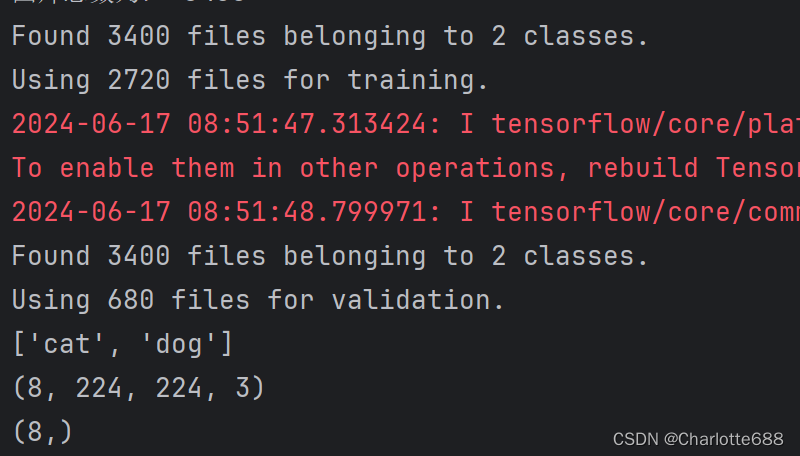DL学习笔记 T8
【TF NOTE】T8 猫狗识别
前言
- 🍨 本文为🔗365天深度学习训练营 中的学习记录博客
- 🍖 原作者:K同学啊
一、设置GPU
import tensorflow as tf
gpus = tf.config.list_physical_devices("GPU")
if gpus:
tf.config.experimental.set_memory_growth(gpus[0],True)
tf.config.set_visible_devices(gpus[0],"GPU")
print(gpus)
输出

二、使用步骤
1.导入数据
#导入数据
import matplotlib.pyplot as plt
plt.rcParams['font.sans-serif'] = ['SimHei']
plt.rcParams['axes.unicode_minus'] = False
import os, PIL, pathlib
import warnings
warnings.filterwarnings('ignore')
data_dir = "D:/BaiduNetdiskDownload/T8"
data_dir = pathlib.Path(data_dir)
image_count = len(list(data_dir.glob('*/*')))
print("图片总数为:",image_count)
输出

2.加载数据
#加载数据
batch_size = 8
img_height = 224
img_width = 224
train_ds = tf.keras.preprocessing.image_dataset_from_directory(
data_dir,
validation_split=0.2,
subset="training",
seed=12,
image_size=(img_height, img_width),
batch_size=batch_size)
val_ds = tf.keras.preprocessing.image_dataset_from_directory(
data_dir,
validation_split=0.2,
subset="validation",
seed=12,
image_size=(img_height,img_width),
batch_size=batch_size)
class_names = train_ds.class_names
print(class_names)
for image_batch, labels_batch in train_ds:
print(image_batch.shape)
print(labels_batch.shape)
break
AUTOTUNE = tf.data.AUTOTUNE
def preprocess_image(image, label):
return (image/255.0,label)
输出

3.归一化
#归一化
train_ds = train_ds.map(preprocess_image, num_parallel_calls = AUTOTUNE)
val_ds = val_ds.map(preprocess_image,num_parallel_calls = AUTOTUNE)
train_ds = train_ds.cache().shuffle(1000).prefetch(buffer_size=AUTOTUNE)
val_ds = val_ds.cache().prefetch(buffer_size=AUTOTUNE)
4.可视化数据
#可视化数据
plt.figure(figsize=(15,10))
for images, labels in train_ds.take(1):
for i in range(8):
ax = plt.subplot(5,8,i+1)
plt.imshow(images[i])
plt.title(class_names[labels[i]])
plt.axis("off")
输出

5.建立模型
VGG模型
我感觉bug是这里的model = VGG16(1000, (img_width, img_height, 3)),这里1000是nb_classes,应该只有两类,我这里改成model = VGG16(2, (img_width, img_height, 3))
from tensorflow.keras import layers, models, Input
from tensorflow.keras.models import Model
from tensorflow.keras.layers import Conv2D, MaxPooling2D, Dense, Flatten, Dropout
def VGG16(nb_classes, input_shape):
input_tensor = Input(shape=input_shape)
#block1
x= Conv2D(64,(3,3),activation='relu',padding='same', name='block1_conv1')(input_tensor)
x = Conv2D(64, (3,3), activation='relu',padding='same', name='block1_conv2')(x)
x = MaxPooling2D((2,2), strides=(2,2), name='block1_pool')(x)
#block2
x= Conv2D(128,(3,3), activation='relu', padding='same', name='block2_conv1')(x)
x = Conv2D(128, (3,3),activation='relu',padding='same', name='block2_conv2')(x)
x = MaxPooling2D((2,2), strides=(2,2), name='block2_pool')(x)
#block3
x = Conv2D(256,(3,3),activation='relu', padding='same',name='block3_conv1')(x)
x = Conv2D(256, (3,3),activation='relu', padding='same',name='block3_conv2')(x)
x = Conv2D(256, (3,3), activation='relu',padding='same', name='block3_conv3')(x)
x = MaxPooling2D((2,2), strides=(2,2),name='block3_pool')(x)
#block4
x= Conv2D(512, (3,3), activation='relu',padding='same', name='block4_conv1')(x)
x = Conv2D(512,(3,3),activation='relu',padding='same',name='block4_conv2')(x)
x = Conv2D(512,(3,3),activation='relu', padding='same', name='block4_conv3')(x)
x = MaxPooling2D((2,2), strides=(2,2),name='block4_pool')(x)
#block5
x = Conv2D(512,(3,3),activation='relu',padding='same',name='block5_conv1')(x)
x = Conv2D(512, (3,3),activation='relu', padding='same', name='block5_conv2')(x)
x = Conv2D(512,(3,3),activation='relu', padding='same', name='block5_conv3')(x)
x = MaxPooling2D((2,2), strides=(2,2),name='block5_pool')(x)
#全连接
x = Flatten()(x)
x = Dense(4096, activation='relu', name='fc1')(x)
x = Dense(4096, activation='relu', name='fc2')(x)
output_tensor = Dense(nb_classes, activation='softmax', name='predictions')(x)
model = Model(input_tensor, output_tensor)
return model
model = VGG16(2, (img_width, img_height, 3))
model.summary()
输出模型简介
Model: "model"
_________________________________________________________________
Layer (type) Output Shape Param #
=================================================================
input_1 (InputLayer) [(None, 224, 224, 3)] 0
block1_conv1 (Conv2D) (None, 224, 224, 64) 1792
block1_conv2 (Conv2D) (None, 224, 224, 64) 36928
block1_pool (MaxPooling2D) (None, 112, 112, 64) 0
block2_conv1 (Conv2D) (None, 112, 112, 128) 73856
block2_conv2 (Conv2D) (None, 112, 112, 128) 147584
block2_pool (MaxPooling2D) (None, 56, 56, 128) 0
block3_conv1 (Conv2D) (None, 56, 56, 256) 295168
block3_conv2 (Conv2D) (None, 56, 56, 256) 590080
block3_conv3 (Conv2D) (None, 56, 56, 256) 590080
block3_pool (MaxPooling2D) (None, 28, 28, 256) 0
block4_conv1 (Conv2D) (None, 28, 28, 512) 1180160
block4_conv2 (Conv2D) (None, 28, 28, 512) 2359808
block4_conv3 (Conv2D) (None, 28, 28, 512) 2359808
block4_pool (MaxPooling2D) (None, 14, 14, 512) 0
block5_conv1 (Conv2D) (None, 14, 14, 512) 2359808
block5_conv2 (Conv2D) (None, 14, 14, 512) 2359808
block5_conv3 (Conv2D) (None, 14, 14, 512) 2359808
block5_pool (MaxPooling2D) (None, 7, 7, 512) 0
flatten (Flatten) (None, 25088) 0
fc1 (Dense) (None, 4096) 102764544
fc2 (Dense) (None, 4096) 16781312
predictions (Dense) (None, 2) 8194
=================================================================
Total params: 134,268,738
Trainable params: 134,268,738
Non-trainable params: 0
_________________________________________________________________
6.编译模型
#编译模型
model.compile(optimizer='adam',
loss='sparse_categorical_crossentropy',
metrics=['accuracy'])
7.训练模型
改用model.train_on_batch方法训练模型
#训练模型
from tqdm import tqdm
import tensorflow.keras.backend as K
epochs = 10
lr = 1e-4
history_train_loss = []
history_train_accuracy = []
history_val_loss = []
history_val_accuracy = []
for epoch in range(epochs):
train_total = len(train_ds)
val_total = len(val_ds)
with tqdm(total=train_total, desc=f'Epoch{epoch +1}/{epochs}', mininterval = 1, ncols = 100) as pbar:
lr = lr*0.92
K.set_value(model.optimizer.lr, lr)
for image, label in train_ds:
history = model.train_on_batch(image,label)
train_loss = history[0]
train_accuracy = history[1]
pbar.set_postfix({"loss":"%.4f"%train_loss,
"accuracy":"%.4f"%train_accuracy,
"lr":K.get_value(model.optimizer.lr)})
pbar.update(1)
history_train_loss.append(train_loss)
history_train_accuracy.append(train_accuracy)
print("开始验证")
with tqdm(total = val_total, desc=f'Epoch{epoch+1}/{epochs}',mininterval = 0.3, ncols =100) as pbar:
for image, label in val_ds:
history = model.test_on_batch(image, label)
val_loss = history[0]
val_accuracy = history[1]
pbar.set_postfix({"loss":"%.4f"%val_loss,
"accuracy":"%.4f"%val_accuracy})
pbar.update(1)
history_val_loss.append(val_loss)
history_val_accuracy.append(val_accuracy)
print('结束验证')
print("验证loss为:%.4f"%val_loss)
print("验证准确率为:%.4f"%val_accuracy)
8.评估模型
#模型评估
epochs_range = range(epochs)
plt.figure(figsize=(12,4))
plt.subplot(1,2,1)
plt.plot(epochs_range, history_train_accuracy, label = 'Training Accuracy')
plt.plot(epochs_range, history_val_accuracy, label = 'Validation Accuracy')
plt.legend(loc = 'lower right')
plt.title('Training and Validation Accuracy')
plt.subplot(1,2,2)
plt.plot(epochs_range, history_train_loss, label = 'Training Loss')
plt.plot(epochs_range, history_val_loss, label = 'Validation Loss')
plt.legend(loc = 'upper right')
plt.title('Training and Validation Loss')
plt.show()
输出
这遍跑的指标特别好,其他跑的就很拉跨

9.预测
#预测
import numpy as np
plt.figure(figsize=(18,3))
plt.suptitle("预测结果展示")
for images, labels in val_ds.take(1):
for i in range(8):
ax = plt.subplot(1,8,i+1)
plt.imshow(images[i].numpy())
img_array = tf.expand_dims(images[i],0)
predictions = model.predict(img_array)
plt.title(class_names[np.argmax(predictions)])
plt.axis("off")
总结
本次运用了model.train_on_batch()进行模型训练,比model.fit()更加多元灵活,t并使用tqdm实现可视化进度条。






















 1423
1423











 被折叠的 条评论
为什么被折叠?
被折叠的 条评论
为什么被折叠?








